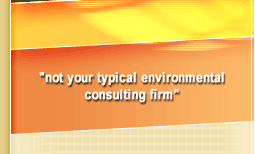Problem
The site is located at the intersection of Park Street and Riverside Park Place in Jacksonville, Florida. The site was formerly used as a retail fuel station that dispensed leaded gasoline, unleaded gasoline and diesel fuel until July 1990. The fueling system and underground storage tanks were removed with approximately 200 to 300 cubic yards of contaminated soil in December 1990. Since this time, the Riverside Methodist Church has used the property as a parking lot for their congregation (Picture 1). Groundwater and soil contamination remained relatively unchanged from 1991 until 1995 despite attempts to remediate the site using a pump and treat system followed by a vacuum extraction and air sparging system. Cleanup work ceased in 1995 due to lack of FDEP Petroleum Cleanup funding.
Assessment work was re-started in late 2001, when the site (then scored a 30) became eligible for FDEP cleanup funds again. The church expressed a desire to cleanup the property as quickly and effectively as possible in order to remove the environmental liability presented by the site. Also, the church was under pressure from the City of Jacksonville to rehabilitate the site and improve the aesthetics of the property to conform to the "Better Jacksonville" plan established in September 2000. Therefore, the church needed a remedial strategy that would allow the church to quickly move forward with future plans for the property.
Solution
TERRA-COM started supplemental assessment work in 2001 (Picture 2). TERRA-COM completed supplemental assessment work at the site in February 2002 and recommended that the site be remediated utilizing source removal.
The technical document detailing the specifications for source removal was submitted to the Florida Department of Environmental Protection (FDEP) through the local Duval County Program in April 2002. This document estimated that 3,300 tons of contaminated soil be removed at an estimated cost of $380,000. FDEP did not approve this approach and instead required a justification document be submitted. After FDEP received this document, FDEP then required that additional testing be performed to verify the conclusions presented by TERRA-COM (June 2002). TERRA-COM completed this additional testing and supplemental documentation that met FDEP's requirements by December 2002. The data provided in the tests confirmed the original position that source removal would be the most cost and technically effective means to remediate the site.
FDEP finally approved the technical approach in March 2003. However, by this time funds again become unavailable due to the relative low score of the site. In the interim, TERRA-COM worked with the church to forestall city code requirements and construction at the site until the source removal could be conducted. In November 2004, funds became available for sites scored 31 or higher. TERRA-COM worked with the church in December 2004 to re-score the site and the site was re-assigned a score of 31.
TERRA-COM then re-applied for approval of the work and received a work order from FDEP for source removal activities in June 2005. Physical work at the site was initiated in July 2005 (Picture 3). Soil contamination at the site extended south and west into the right-of-ways of both Park Street and Riverside Park Place. In order to remove as much contaminated soil as possible, TERRA-COM installed sheet piling along these roadways (Picture 4 & Picture 5) and excavated contaminated soil as deep as 26 feet below the land surface. TERRA-COM also had to demolish an existing building located within the area of the contaminated soil (Picture 6). TERRA-COM removed 2,935 tons of contaminated soil from the site and work was completed in August 2005 (Picture 7, Picture 8, & Picture 9). TERRA-COM then worked with the church and FDEP to insure that the site was restored properly to meet all city and FDEP requirements (Picture 10).
Upon completion of this work, funding issues again caused follow-up sampling to be suspended. However, TERRA-COM was able to finish the work the church needed before the funds were withdrawn. During the entire 3 1/2-year process, TERRA-COM kept the needs of the site owner at the forefront in order to bring the work to completion during the limited opportunities that were provided. TERRA-COM not only removed the soil contamination, but used this effort to help the church re-build the property (Pictures 11 & Picture 12). Through TERRA-COM's efforts, the restored property not only met city code, but the remedial and restoration efforts created a more useful and aesthetically pleasing property for substantially less cost (Picture 13).


